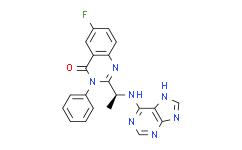| DC7238 |
Gedatolisib(PKI-587)
|
PKI-587 is a highly potent dual PI3K/mTOR kinase inhibitor with IC50 of 0.4 nM and <0.1 μM for PI3K-α and mTOR, respectively. |
| DC5072 |
Duvelisib (IPI-145, INK1197)
|
Duvelisib (IPI-145) is a selective inhibitor of the p110δ isoform, exhibiting IC50 values of 2.5 nM, 27.4 nM, 85 nM, and 1602 nM for p110δ, p110γ, p110β, and p110α, respectively, highlighting its specificity and potency. |
| DC5068 |
Idelalisib (CAL-101,GS-1101)
|
CAL-101 is a selective p110δ inhibitor with IC50 of 2.5 nM; shown to have 40- to 300-fold greater selectivity for p110δ thanp110α/β/γ, and 400- to 4000-fold more selectivity to p110δ than C2β, hVPS34, DNA-PK and mTOR. |
| DC5154 |
BKM120 (NVP-BKM120, Buparlisib)
|
BKM120 is a selective PI3K inhibitor of p110α/β/δ/γ with IC50 of 52 nM/166 nM/116 nM/262 nM, respectively. Reduced potency against VPS34, mTOR, DNAPK, with little activity to PI4Kβ. |
| DC8760 |
Acalisib
|
Acalisib (GS-9820) is a potent and selective inhibitor of PI3Kδ with IC50 value of 12.7 nM. |






















